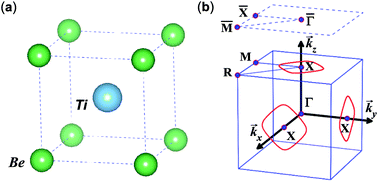Strong anisotropic nodal lines in the TiBe family†
Abstract
Using first-principles calculations and k·p model analysis, we find that Dirac nodal lines (DNLs) exist in low energy band structures of real materials of the body-centered cubic TiBe family. The nodal lines are protected by mirror reflection symmetries of the systems. The anisotropic electronic state interaction around the Fermi level produces a strong anisotropic quasi-square shape nodal line in the systems. Moreover, all the systems demonstrate drumhead surface states spanning a large energy window showing their potential in terms of high temperature superconductivity. The slight gap induced by spin–orbit coupling (SOC) indicates that materials of the TiBe family are promising candidates for future experimental studies on nontrivial topological semimetals.



 Please wait while we load your content...
Please wait while we load your content...